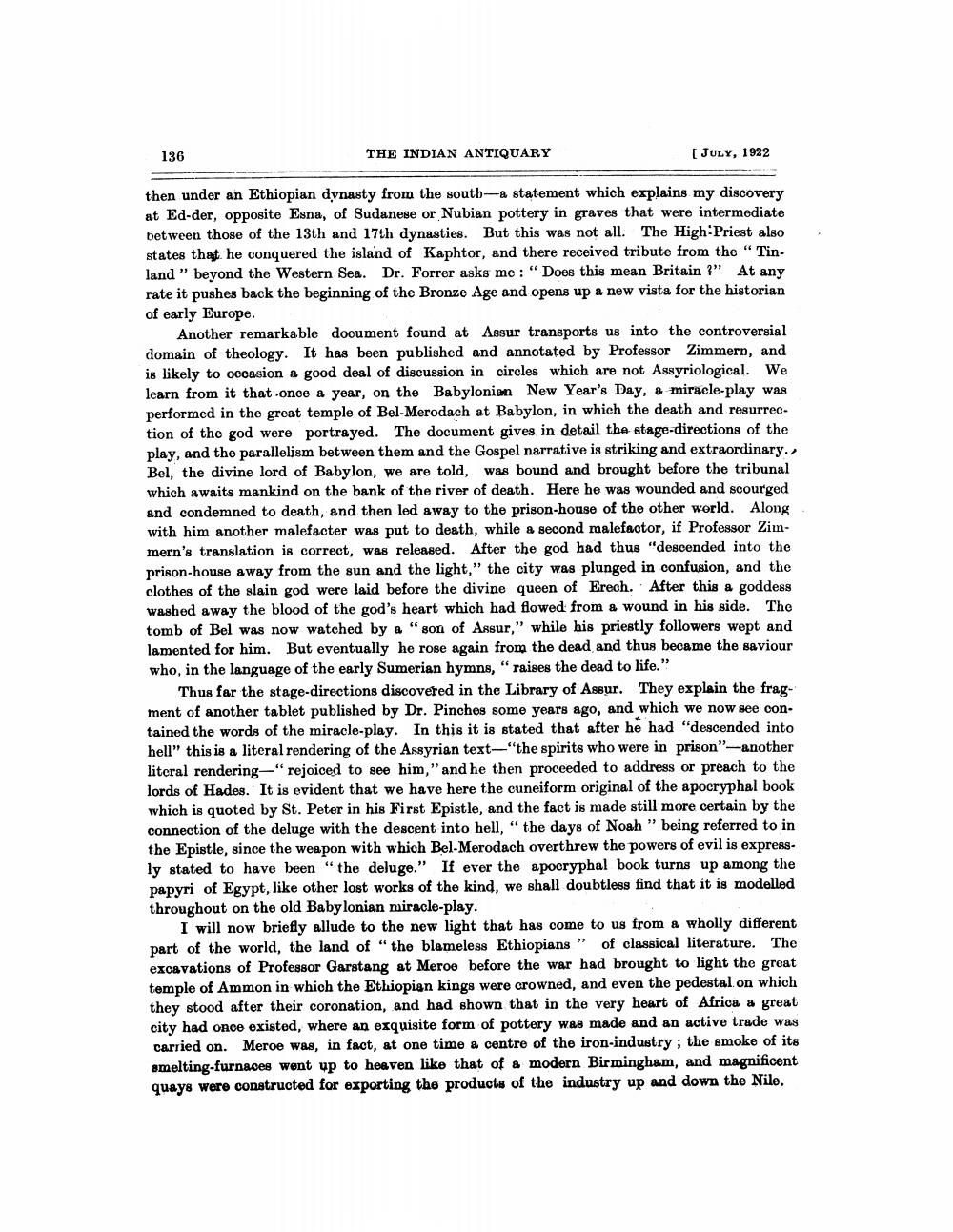________________
136
THE INDIAN ANTIQUARY
[ JULY, 1922
then under an Ethiopian dynasty from the south-a statement which explains my discovery at Ed-der, opposite Esna, of Sudanese or Nubian pottery in graves that were intermediate between those of the 13th and 17th dynasties. But this was not all. The High Priest also states that he conquered the island of Kaphtor, and there received tribute from the "Tinland" beyond the Western Sea. Dr. Forrer asks me: "Does this mean Britain?" At any rate it pushes back the beginning of the Bronze Age and opens up a new vista for the historian of early Europe.
Another remarkable document found at Assur transports us into the controversial domain of theology. It has been published and annotated by Professor Zimmern, and is likely to occasion a good deal of discussion in circles which are not Assyriological. We learn from it that once a year, on the Babylonian New Year's Day, a miracle-play was performed in the great temple of Bel-Merodach at Babylon, in which the death and resurrection of the god were portrayed. The document gives in detail the stage-directions of the play, and the parallelism between them and the Gospel narrative is striking and extraordinary. Bel, the divine lord of Babylon, we are told, was bound and brought before the tribunal which awaits mankind on the bank of the river of death. Here he was wounded and scourged and condemned to death, and then led away to the prison-house of the other world. Along with him another malefacter was put to death, while a second malefactor, if Professor Zimmern's translation is correct, was released. After the god had thus "descended into the prison-house away from the sun and the light," the city was plunged in confusion, and the clothes of the slain god were laid before the divine queen of Erech. After this a goddess washed away the blood of the god's heart which had flowed from a wound in his side. The tomb of Bel was now watched by a "son of Assur," while his priestly followers wept and lamented for him. But eventually he rose again from the dead and thus became the saviour who, in the language of the early Sumerian hymns, "raises the dead to life."
Thus far the stage-directions discovered in the Library of Assur. They explain the fragment of another tablet published by Dr. Pinches some years ago, and which we now see contained the words of the miracle-play. In this it is stated that after he had "descended into hell" this is a literal rendering of the Assyrian text-"the spirits who were in prison"-another literal rendering-" rejoiced to see him," and he then proceeded to address or preach to the lords of Hades. It is evident that we have here the cuneiform original of the apocryphal book which is quoted by St. Peter in his First Epistle, and the fact is made still more certain by the connection of the deluge with the descent into hell, "the days of Noah " being referred to in the Epistle, since the weapon with which Bel-Merodach overthrew the powers of evil is expressly stated to have been "the deluge." If ever the apocryphal book turns up among the papyri of Egypt, like other lost works of the kind, we shall doubtless find that it is modelled throughout on the old Babylonian miracle-play.
I will now briefly allude to the new light that has come to us from a wholly different part of the world, the land of "the blameless Ethiopians" of classical literature. The excavations of Professor Garstang at Meroe before the war had brought to light the great temple of Ammon in which the Ethiopian kings were crowned, and even the pedestal on which they stood after their coronation, and had shown that in the very heart of Africa a great city had once existed, where an exquisite form of pottery was made and an active trade was carried on. Meroe was, in fact, at one time a centre of the iron-industry; the smoke of its smelting-furnaces went up to heaven like that of a modern Birmingham, and magnificent quays were constructed for exporting the products of the industry up and down the Nile.




